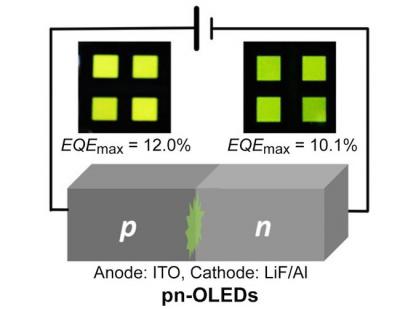Researchers from South China University of Technology developed a new OLED structure that promises to enable low-cost efficient fluorescent OLED devices. The so-called pn-OLED structure is inspired by p-n junction theory and inorganic LED design.

The pn-OLED uses a highly-efficient emission-layer-free OLED, in which the p-type and n-type organic semiconductors are sandwiched vertically between an ITO anode and a lithium fluoride/aluminum cathode. The luminescent center of the pn-OLED is located in the pn junction region. The light-emission behavior of this device is a result of the synergetic energy release from both the p-type and n-type materials. This is in contrast to conventional OLEDs, where the light generation occurs from single-molecule emitters.
The researchers say that this OLED structure has a potential to achieve extremely high efficiency - close to the theoretical maximum 100% internal quantum efficiency. pn-OLEDs also require low operating voltages, which results in very high power-conversion efficiencies. The researchers still need to investigate the operating mechanism of the pn-OLEDs, and also examine the underlying connections of the working principles of both organic and inorganic pn junction LEDs.
Comments
Yes, this is just a simple exciplex. It is C. Adachi who firstly developed this idea to be applicable. I do not understand how this university dares to claim this credit. By the way, this exciplex method seesm to offer short lifetime, due to the charge confinement at the pn junction.


This is a simple exciplex OLED, it's been known for more than 10 years, it is not new at all!